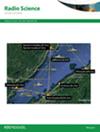Strategy for WiFi interference detection in weather radar applications
IF 1.5
4区 地球科学
Q3 ASTRONOMY & ASTROPHYSICS
引用次数: 0
Abstract
In the current context of intensive spectrum use by communications systems, WiFi systems have been allowed to use bands previously reserved for weather radars, as opportunity users. Some drawbacks in spectrum management make WiFi systems a source of interference that degrades the quality of observables obtained by C-band weather radars. In this work we present a strategy to detect these interfering WiFi packets at the output signal of the radar matched filter. The strategy is based on a delay and correlate algorithm that exploits the periodic structure of the WiFi packets preamble, periodicity that remains unchanged even though the signal is distorted when passing through the radar reception stages. We formulate the detection strategy as a hypothesis test that uses the squared modulus of the auto-correlation as the statistic, extended to a constant false alarm (CFAR) formulation to cope with the unknown noise power. We evaluate analytically and through numerical simulations the performance of the test in terms of detection probability. We also perform a series of controlled experiments using real-world weather radar data collected by Argentinian C-band RMA radars. The results show a high detection rate both when WiFi interference is in regions where there is only noise and when it is in regions where there is also a meteorological target.气象雷达应用中WiFi干扰检测策略
在当前通信系统密集使用频谱的背景下,WiFi系统被允许使用以前为气象雷达保留的频段,作为机会用户。频谱管理的一些缺陷使WiFi系统成为干扰源,降低了c波段气象雷达获得的观测数据的质量。在这项工作中,我们提出了一种在雷达匹配滤波器的输出信号处检测这些干扰WiFi数据包的策略。该策略基于延迟和相关算法,该算法利用了WiFi数据包序言的周期性结构,即使信号在通过雷达接收阶段时失真,周期性也保持不变。我们将检测策略制定为使用自相关的平方模量作为统计量的假设检验,并将其扩展为恒定虚警(CFAR)公式以应对未知的噪声功率。我们通过分析和数值模拟来评估测试在检测概率方面的性能。我们还使用阿根廷c波段RMA雷达收集的真实天气雷达数据进行了一系列对照实验。结果表明,无论是在只有噪声的区域,还是在同时存在气象目标的区域,WiFi干扰的检出率都很高。
本文章由计算机程序翻译,如有差异,请以英文原文为准。
求助全文
约1分钟内获得全文
求助全文
来源期刊

Radio Science
工程技术-地球化学与地球物理
CiteScore
3.30
自引率
12.50%
发文量
112
审稿时长
1 months
期刊介绍:
Radio Science (RDS) publishes original scientific contributions on radio-frequency electromagnetic-propagation and its applications. Contributions covering measurement, modelling, prediction and forecasting techniques pertinent to fields and waves - including antennas, signals and systems, the terrestrial and space environment and radio propagation problems in radio astronomy - are welcome. Contributions may address propagation through, interaction with, and remote sensing of structures, geophysical media, plasmas, and materials, as well as the application of radio frequency electromagnetic techniques to remote sensing of the Earth and other bodies in the solar system.
 求助内容:
求助内容: 应助结果提醒方式:
应助结果提醒方式:


